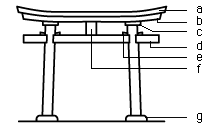|
||
 |
||

@
(C)2001 Japanese Architecture and Art Net Users System.@No reproduction or republication without written permission.
fΪΜeLXgEΚ^ECXgΘΗASΔΜRecΜ³f‘»E]ΪπΦΆά·B
|
||||||
| @ | ||||||
| inari torii@ξΧΉ | ||||||
| KEY WORD :@architecture / shrines | ||||||
| @ | ||||||
| A type of gate-like structure *torii Ή at inari ξΧ shrines, which is characterized by a pillar that has a rounded, bowl-shaped base. Sometimes called daiwa torii δΦΉ because a circular plate *daiwa δΦ, is placed on top of each pillar to prevent the seepage of rainwater into the crosscut of the pillar. The end of the top lintel *kasagi }Ψ, is thicker than the center and has a strong upward curve. The ends of both the top and secondary lintel *shimaki Ψ, are cut with a downward slant. The tie beam *nuki Ρ, is straight, rectangular in section, and secured by wedges *kusabi Ά, inserted into each side of the pillars. Its ends are straight-cut. A center strut, gakuzuka z©, is placed between the shimaki and nuki. Except for the daiwa, this torii closely resembles a *myoujin torii Ύ_Ή. When constructed of wood, it is usually painted vermillion. The proportions of the inari torii are the same as those of the main part of the *ryoubu torii ΌΉ and the pillars have the same inward incline *uchikorobi ΰ]. Examples: Fushimi Inari Jinja ©ξΧ_Π, Kyoto; Oogaki Hachimanguu ε_ͺ¦{, Gifu prefecture. | ||||||
| @ | ||||||

|
||||||
@ |
||||||
| REFERENCES: | ||||||
| @ | ||||||
| EXTERNAL LINKS: | ||||||
| @@ | ||||||
| NOTES: | ||||||
| @ | ||||||
(C)2001 Japanese Architecture and Art Net Users System.@No reproduction or republication without written permission. fΪΜeLXgEΚ^ECXgΘΗASΔΜRecΜ³f‘»E]ΪπΦΆά·B |
||||||
| @ |